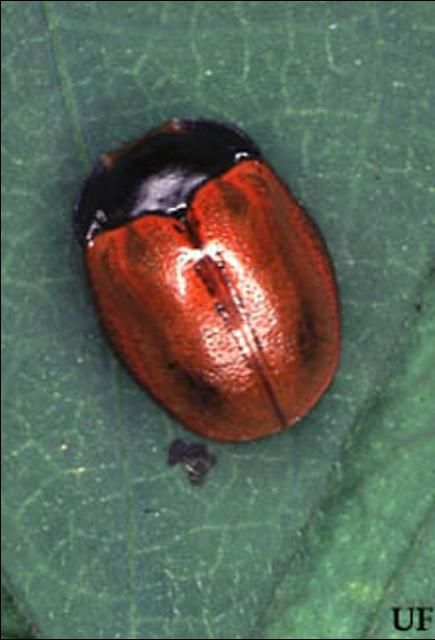Tortoise Beetle ,Chelymorpha cribraria (Fabricius) (Insecta: Coleoptera: Chrysomelidae)
The Featured Creatures collection provides in-depth profiles of insects, nematodes, arachnids and other organisms relevant to Florida. These profiles are intended for the use of interested laypersons with some knowledge of biology as well as academic audiences.
Introduction
In September of 1993, a single specimen of an exotic tortoise beetle was collected on a species of Ipomoea (Convolvulaceae) in a weedy lot in Davie, Broward County. Further collecting turned up additional specimens at the original site and at other localities in Broward County. The beetle was identified as Chelymorpha cribraria (Fabricius), a widely distributed Neotropical species known to feed on sweet potato (Ipomoea batatas (L.) Lam.) and other morning glories. Subsequent surveys and collecting have revealed populations of C. cribraria at other localities in Dade and Monroe counties.
Distribution
This species is distributed throughout South America and the Antilles. Buzzi (1988) recorded C. cribraria from Brazil, Cayenne, Colombia, Guadeloupe, and Paraguay. There are specimens in the Florida State Collection of Arthropods from Antigua, Argentina, Dominican Republic, and Panama. In Florida, it has been collected in the following localities: Broward Co.: Davie, Hallandale; Dade Co.: Camp Mahachee, Cape Florida State Park, Matheson Hammock, Virginia Key; Monroe Co.: Key Largo State Botanical Site.
Identification
The genus Chelymorpha Boheman contains more than 100 species, which are mostly Neotropical in distribution. Two species have been recorded (Blatchley 1924) previously from Florida: C. cassidea (Fabricius) and C. geniculata Boheman. The endemic Florida C. geniculata has had a checkered taxonomic history. It is often considered either a synonym or subspecies of C. cassidea (Balbaugh and Hays 1972). Both are uniformly tan to red-brown in color with 12 to 14 black spots on the elytra and four to six on the pronotum. Chelymorpha cribraria is extremely polymorphic in color (Vasconcellos-Neto 1988), and most of the color forms have been described as separate species. Only two color forms have been found in Florida so far. The most common color form in Florida is bicolored, with pronotum black and elytra brick-red or tan. Much less common is the color form having a tan ground color with metallic reflections, numerous black speckles, and longitudinal red stripes on the elytra.

Credit: Jeffrey Lotz, Division of Plant Industry

Credit: James Castner, UF/IFAS
Vasconcellos-Neto (1988) presented a model consisting of six tightly-linked genes responsible for color in C. cribraria. He found eight color forms produced from 21 genotypes, and hypothesized that the stable polymorphism in C. cribraria is maintained "... by selection through visually oriented predators." Adult C. cribraria are unpalatable to some predators. In Brazil, C. cribraria appears to belong to at least six different mimicry groups with two to four beetle species in each group.
Biology
Buzzi (1988) reviewed the biology of Neotropical cassidines and gave the following composite account of several species of Brazilian Chelymorpha, including C. cribraria: Eggs are glued to leaves of the host plant in clusters; they hatch in six to eight days. There are five larval instars and time spent in the larval stage ranges from 13 to 18 days. Larvae possess a fecal fork and carry their feces over their body. This camouflage is thought to provide protection from predators and parasitoids. Pupation, which takes place on the host plant and under the fecal shield, lasts eight to 10 days. Females live an average of six months and lay about 1,500 eggs.
Hosts
Chelymorpha cribraria has been recorded in the Neotropics from several species of Ipomoea, such as I. cairica (L.) Sweet. Per., I. cardiophylla Gray, and I. batatas (sweet potato). In Florida, it has been collected on various morning glories, but the only two that have been identified to species are I. indica (Burm. f.) Merr. and I. pes-capre (L.) R. Br., railroad vine. The two morning glories on Florida's list of endangered plants, Ipomoea microdactyla Griseb. and I. tensuissima Choisy (Coile 1994), occur in the areas where C. cribraria is established.
Acknowledgments
I thank E.G. Riley, Texas A&M University, for his help in identifying C. cribraria; Deborah L. Matthews and John Watts, University of Florida, for bringing the first specimen to my attention; Bonnie Coy, FDACS, for additional surveys; Roy Morris, Lakeland, for the specimen from Key Largo; and Jim Duquesnel, Florida Department of Environmental Protection, for finding the population of C. cribraria at Cape Florida.
Selected References
Balsbaugh, E.U., Jr. and K.L. Hays. 1972. The leaf beetles of Alabama (Coleoptera: Chrysomelidae). Auburn University, Agricultural Experiment Station Bulletin 441. 223 p.
Blatchley, W.S. 1924. The Chrysomelidae of Florida. The Florida Entomologist 7: 33–39; 7: 49–57; 8: 1–7; 8: 17–23; 8: 39–46.
Buzzi, Z.J. 1988. Biology of Neotropical Cassidinae. pp. 559–580. In P. Jolivet, E. Petipierre, and T.H. Hsiao (eds.). Biology of Chrysomelidae. Kluwer Academic Publishers, Dordrecht.
Coile, N.C. 1994. Florida's endangered and threatened plants. Florida Department of Agriculture and Consumer Services, Bureau of Entomology, Nematology and Plant Pathology - Botany Contribution No. 29. 56 unnumbered p.
Vasconcellos-Neto, J. 1988. Genetics of Chelymorpha cribraria, Cassidinae: colour patterns and their ecological meanings. pp. 217–232. In P. Jolivet, E. Petitpierre, and T.H. Hsiao (eds.). Biology of Chrysomelidae. Kluwer Academic Publishers, Dordrecht.



